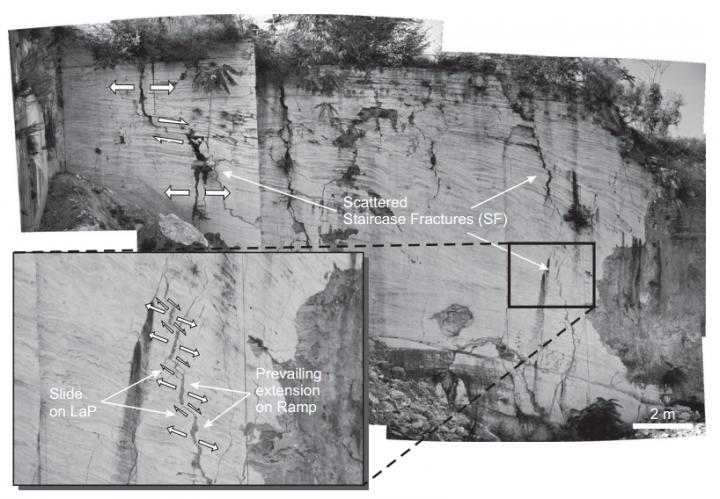In the new GSA BULLETIN, Matteo Maggi and colleagues from Italy and Brazil present a new model of the development of fractures showing a stairway trajectory, commonly occurring in finely laminated rock, such microbialites and travertines.
These fractures strongly enhance permeability by connecting several highly porous zones enveloped in tight impermeable levels. Understanding and predicting this fracture pattern geometry, distribution, and interconnection is valuable not only for locating water supplies, but also for oil, gas, and geothermal exploration.
Major discoveries of hydrocarbon have recently been made in continental (lacustrine) microbial carbonates in the Brazilian South Atlantic margin, some of which exhibit a texture similar to those usually observed in travertines.

Examples of gentle slope deposits are shown. Scattered fractures with staircase geometry show prevailing extension in the ramps. Credit: GSA Bulletin and Maggi et al.
Understanding of these lacustrine carbonates is still at an early stage. Given that in modern rift settings, vent-related thermal (travertine) and non-thermal (tufa) carbonates are a major component, the proposed conceptual model of staircase fracture localization contributes to the preparation of a model for the occurrence of high-permeability pathways in hydrocarbon and geothermal microbial reservoirs.
Citation: Staircase fractures in microbialites and the role of lamination-related mechanical anisotropy: The example of the Acquasanta Terme travertine deposits (central Italy) M. Maggi et al., Università degli Studi Roma Tre, Roma, Italy. 22 Jan. 2015; http://dx.doi.org/10.1130/B31163.1.




Comments